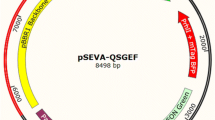Abstract
A novel bacterial growth monitoring method using a tunable resistive pulse sensor (TRPS) system is introduced in this study for accurate and sensitive measurement of cell size and cell concentration simultaneously. Two model bacterial strains, Bacillus subtilis str.168 (BSU168) and Escherichia coli str.DH5α (DH5α), were chosen for benchmarking the growth-monitoring performance of the system. Results showed that the technique of TRPS is sensitive and accurate relative to widely used methods, with a lower detection limit of cell concentration measurement of 5 × 105 cells/ml; at the same time, the mean coefficient of variation from TRPS was within 2 %. The growth of BSU168 and DH5α in liquid cultures was studied by TRPS, optical density (OD), and colony plating. Compared to OD measurement, TRPS-measured concentration correlates better with colony plating (R = 0.85 vs. R = 0.72), which is often regarded as the gold standard of cell concentration determination. General agreement was also observed by comparing TRPS-derived cell volume measurements and those determined from microscopy. We have demonstrated that TRPS is a reliable method for bacterial growth monitoring, where the study of both cell volume and cell concentration are needed to provide further details about the physical aspects of cell dynamics in real time.





Similar content being viewed by others
References
Begot C, Desnier I, Daudin JD, Labadie JC, Lebert A (1996) Recommendations for calculating growth parameters by optical density measurements. J Microbiol Methods 25(3):225–232
Booth MA, Vogel R, Curran JM, Harbison S, Travas-Sejdic J (2013) Detection of target-probe oligonucleotide hybridization using synthetic nanopore resistive pulse sensing. Biosens Bioelectron 45:136–140
Brown C (1998) Coefficient of variation. Applied multivariate statistics in geohydrology and related sciences. Springer, Berlin, pp 155–157
Davey HM, Kell DB (1996) Flow cytometry and cell sorting of heterogeneous microbial populations: the importance of single-cell analyses. Microbiol Rev 60(4):641–696
de Vrij J, Maas SL, van Nispen M, Sena-Esteves M, Limpens RW, Koster AJ, Leenstra S, Lamfers ML, Broekman ML (2013) Quantification of nanosized extracellular membrane vesicles with scanning ion occlusion sensing. Nanomedicine (London) 8(9):1443–1458
DeBlois RW, Wesley RK (1977) Sizes and concentrations of several type C oncornaviruses and bacteriophage T2 by the resistive-pulse technique. J Virol 23(2):227–233
DeBlois RW, Bean CP, Wesley RKA (1977) Electrokinetic measurements with submicron particles and pores by the resistive pulse technique. J Colloid Interface Sci 61(2):323–335
Fraikin J-L, Teesalu T, McKenney CM, Ruoslahti E, Cleland AN (2011) A high-throughput label-free nanoparticle analyser. Nat Nanotechnol 6(5):308–313
Garcia-Armesto MR, Prieto M, Garcia-Lopez ML, Otero A, Moreno B (1993) Modern microbiological methods for foods: colony count and direct count methods. A review. Microbiologia 9(1):1–13
Garza-Licudine E, Deo D, Yu S, Uz-Zaman A, Dunbar WB (2010) Portable nanoparticle quantization using a resizable nanopore instrument—the IZON qNano. Conf Proc IEEE Eng Med Biol Soc 2010:5736–5739
Gazzola D, Van Sluyter SC, Curioni A, Waters EJ, Marangon M (2012) Roles of proteins, polysaccharides, and phenolics in haze formation in white wine via reconstitution experiments. J Agric Food Chem 60(42):10666–10673
Greif D, Wesner D, Regtmeier J, Anselmetti D (2010) High resolution imaging of surface patterns of single bacterial cells. Ultramicroscopy 110(10):1290–1296
Gunasekera TS, Attfield PV, Veal DA (2000) A flow cytometry method for rapid detection and enumeration of total bacteria in milk. Appl Environ Microbiol 66(3):1228–1232
Henriques AO, Glaser P, Piggot PJ, Moran CP Jr (1998) Control of cell shape and elongation by the rodA gene in Bacillus subtilis. Mol Microbiol 28(2):235–247
Katsuda T, Tsuchiya R, Kosaka N, Yoshioka Y, Takagaki K, Oki K, Takeshita F, Sakai Y, Kuroda M, Ochiya T (2013) Human adipose tissue-derived mesenchymal stem cells secrete functional neprilysin-bound exosomes. Sci Rep 3:1197
Kepner RL Jr, Pratt JR (1994) Use of fluorochromes for direct enumeration of total bacteria in environmental samples: past and present. Microbiol Rev 58(4):603–615
Koch AL (1968) Theory of the angular dependence of light scattered by bacteria and similar-sized biological objects. J Theor Biol 18(1):133–156
Koch AL (1970) Turbidity measurements of bacterial cultures in some available commercial instruments. Anal Biochem 38(1):252–259
Kubitschek HE (1990) Cell volume increase in Escherichia coli after shifts to richer media. J Bacteriol 172(1):94–101
Lawrence JV, Maier S (1977) Correction for the inherent error in optical density readings. Appl Environ Microbiol 33(2):482–484
Lumley MA, Burgess R, Billingham LJ, McDonald DF, Milligan DW (1997) Colony counting is a major source of variation in CFU-GM results between centres. Br J Haematol 97(2):481–484
Matlock BC, Beringer RW, Ash DL, Page AF (2011) Differences in bacterial optical density measurements between spectrophotometers. Thermo Fisher Scientific. http://www.thermoscientific.de/eThermo/CMA/PDFs/Product/productPDF_58468.PDF
Rolfe MD, Rice CJ, Lucchini S, Pin C, Thompson A, Cameron AD, Alston M, Stringer MF, Betts RP, Baranyi J, Peck MW, Hinton JCD (2012) Lag phase is a distinct growth phase that prepares bacteria for exponential growth and involves transient metal accumulation. J Bacteriol 194(3):686–701
Shapiro HM (2003) Practical flow cytometry. Wiley-Liss, New York
Vogel R, Willmott G, Kozak D, Roberts GS, Anderson W, Groenewegen L, Glossop B, Barnett A, Turner A, Trau M (2011) Quantitative sizing of nano/microparticles with a tunable elastomeric pore sensor. Anal Chem 83(9):3499–3506
Volkmer B, Heinemann M (2011) Condition-dependent cell volume and concentration of Escherichia coli to facilitate data conversion for systems biology modeling. PLoS ONE 6(7):e23126
Winson MK, Davey HM (2000) Flow cytometric analysis of microorganisms. Methods 21(3):231–240
Wong JT (1983) Membership mutation of the genetic code: loss of fitness by tryptophan. Proc Natl Acad Sci U S A 80(20):6303–6306
Acknowledgments
This work is supported by the Hong Kong RGC Collaborative Research Fund (CUHK3/CRF/11G), the Lo Kwee-Seong Biomedical Research Fund, and the Lee Hysan Foundation.
Author information
Authors and Affiliations
Corresponding authors
Electronic supplementary material
Below is the link to the electronic supplementary material.
ESM 1
(PDF 4555 kb)
Rights and permissions
About this article
Cite this article
Yu, A.C.S., Loo, J.F.C., Yu, S. et al. Monitoring bacterial growth using tunable resistive pulse sensing with a pore-based technique. Appl Microbiol Biotechnol 98, 855–862 (2014). https://doi.org/10.1007/s00253-013-5377-9
Received:
Accepted:
Published:
Issue Date:
DOI: https://doi.org/10.1007/s00253-013-5377-9




